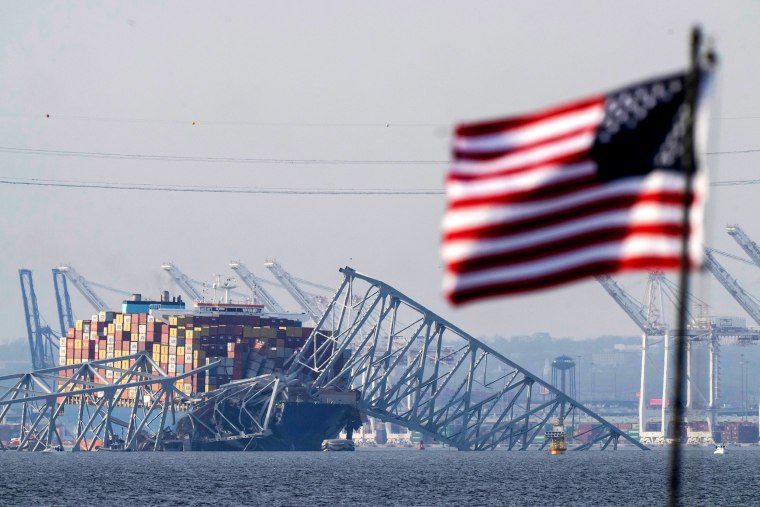The Dali cargo ship was cruising away from the Port of Baltimore when its lights suddenly went out just after 1:24 a.m. Tuesday.
The Singaporean vessel, which stretches nearly 1,000 feet long, had apparently lost power. It was now effectively rudderless and at the mercy of the currents.
“The worst sound you ever hear on a ship is dead silence, because that means everything’s gone wrong,” said Salvatore Mercogliano, a maritime expert and historian.
Four minutes later, the Dali crashed into the Francis Scott Key Bridge. The 1.6-mile span crumpled into the harbor within seconds. Six construction workers who were filling potholes on the bridge remain missing.
Video of the ship, emergency radio transmissions and analysis from maritime veterans paint a picture of a disastrous scenario. It is rare for ships of that size to lose power and rarer still for it to happen in a narrow channel near the pillars of a major bridge. A last-minute mayday and quick actions on the ground most likely averted a much higher casualty count.

“Hold all traffic on the Key Bridge,” an unidentified first responder said over emergency radio transmissions posted online by Broadcastify, a website that streams and records radio communications. “There’s a ship approaching that just lost their steering.”
At that point, the Dali was drifting, powerless, toward the bridge at a speed of about 8 knots. Maritime experts said there was most likely little the crew could have done to avert catastrophe.
“An engine conking out 3 miles out in the ocean is an aggravation and an economic problem, because you lose time,” said Henry Lipian, a retired Coast Guard lieutenant and founder of the Introtech accident reconstruction firm. “In a narrow channel at night, with a bridge in front of you, I couldn’t think of a worse situation to deal with.”
A ship can drop anchor in an attempt to avert a collision, but given the Dali’s size, speed and distance from the bridge, such a move most likely wouldn’t have helped, said Morgan McManus, an instructor at SUNY Maritime College in New York who has worked on cargo ships and tankers.
“At 8 knots you need a couple thousand yards to do it,” McManus said.
Investigators are now working to piece together what happened. Lipian said he suspected that fuel or an issue with the fuel system might have been the culprit.
“While in port, did they take on a load of fuel?” he said. “Was it the proper grade of fuel? Was it contaminated?”
The ship had data recorders on board, but they have yet to be analyzed, officials said.
“We chose not to board the vessel today to allow some time for the search and recovery, which we did not want to interfere with,” said Jennifer Homendy, chair of the National Transportation and Safety Board.
She described the recorder as a “critical piece of our investigation.”
An inspection of the Dali in Chile in June noted “deficiencies” in “propulsion and auxiliary machinery,” including gauges and thermometers, according to data on the website Equasis, which publishes safety-related information about ships. But the Dali had subsequent inspections, including one in September in New York, in which no deficiencies were noted.
Experts cautioned not to read too much into the deficiencies recorded in June. They could have been a result of something minor, like paperwork issues.
The Dali, a Singaporean-flagged vessel chartered by the Danish shipping giant Maersk, was bound for Sri Lanka.
“We are horrified by what has happened in Baltimore, and our thoughts are with all of those affected,” Maersk said in a statement. “We are closely following the investigations.”
Synergy Marine Group, which operates and manages the ship, said that two port pilots were at the helm of the Dali at the time of the crash and that all 22 crew members on board were accounted for. Port, or bay, pilots play a crucial role in helping large ships navigate narrow waterways. They hop on ships approaching ports and hop off after they leave the harbors, using their extensive knowledge of their areas to guide vessels to safety.
“There’s very little margin of error going through some of these ship channels,” said Mercogliano, the maritime expert, who is an adjunct professor at the U.S. Merchant Marine Academy and a history professor at Campbell University in North Carolina.
Mercogliano said a local tugboat operator who heard the mayday call told him a pilot issued it.
“What the pilot did was what they were supposed to do,” Mercogliano said.
Containerships' colliding with bridges is rare but not unheard of. Last month, a cargo vessel struck a bridge outside the city of Guangzhou, China, causing a section of the roadway to come crashing down, killing five people.
The deadliest such collision in the U.S. occurred in 1980, when a cargo ship rammed into the Sunshine Skyway Bridge in Tampa Bay, Florida, bringing it down and killing 35.
Dramatic video captured the moment the Key Bridge tumbled into the water at 1:28 a.m. Tuesday.
The boat’s lights, after having gone out at 1:24 a.m., went back on one minute later, and dark smoke began billowing from the ship’s chimney. Then, at 1:26 a.m., the ship appeared to turn sharply. Before it slammed into the bridge, the Dali’s lights flicked off and on again.
Local residents said they were shocked by the sight of the gaping hole above the bay where the bridge had stood for nearly a half-century.
“It’s literally at the end of the street; you see it coming home every day,” said William Reynolds, of Dundalk. “And now it’s just not there.”

